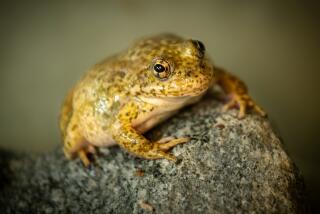Officials Tour Habitat of Rare Flower, Frog
A contingent of top brass, biologists and staff members from two state and federal wildlife agencies visited Ahmanson Ranch Friday to examine the habitat of a rare flower and an endangered frog on the site of a proposed housing project.
The tour of the Ventura County property where a long-debated, 3,050-home development is proposed by Washington Mutual preceded an expected decision by the U.S. Fish and Wildlife Service and the state Department of Fish and Game on whether to issue permits allowing the project to proceed.
The message that emerged late Friday was that the spineflower, a plant thought to be extinct, cannot be disturbed.
“They clearly understand that they have to save the land where the spineflowers are . . . don’t build on it,” said Michael Spear, California-Nevada operations manager for Fish and Wildlife, who attended the 4 1/2-hour tour and meeting.
Tim McGarry, a vice president for Washington Mutual, said he could not comment on the statement “not having been in on the discussions today.”
“We’re having discussions and we are working collaboratively to find the best way to preserve the species on the ranch,” McGarry added. “Those discussions are ongoing.”
Spear said about 10 representatives from Fish and Wildlife and state Fish and Game met with 10 Washington Mutual officials, biologists and consultants, examining plants and the hilly 2,800-acre property north of the Ventura Freeway near Calabasas.
Most of the afternoon was spent inside the ranch house where discussions centered on the San Fernando spineflower.
But Rep. Brad Sherman (D-Sherman Oaks) protested the omission of his environmental deputy, Susan Little, who sought to attend the session.
“What are they trying to hide? It was purely Washington Mutual that doesn’t want us there,” Sherman said Friday after the meeting.
“We expected that Mike [Spears] would insist that my environmental deputy, Susan, would be at the meeting. Ultimately Mr. Spears did not.”
McGarry, however, said the agencies and Washington Mutual needed to work without distractions from political aides or media members.
“Generally, agencies do fact-finding in this manner,” McGarry said.
Bob Hight, state Fish and Game director, attended but could not be reached for comment Friday.
Sherman has sought a new environmental report for Ahmanson Ranch because of the discovery of the spineflower and the California red-legged frog--neither of which were listed in the current environmental study approved in 1992.
Federal Fish and Wildlife will provide comments to the Army of Corps of Engineers regarding waterways and wetlands permits. Fish and Wildlife must also issue a permit before a required habitat conservation plan can proceed.
Spear said Friday’s discussions looked at issues including whether the spineflower grows in thin or heavier soils. This year 1.4 million plants in 16 locations were found, with some locations no larger than 10 by 10 feet, he said. Last year about 25,000 of the plants were found.
Before key permit decisions are made, Sherman said, he wants a biologist hired by the city of Calabasas to examine the habitat and the spineflowers.
“It doesn’t matter how good a referee is,” Sherman said, referring to state and federal agencies, “you have to let both teams on the field.”
The request was denied, McGarry said.
“The agencies represent the public,” McGarry said. “The appropriate agencies in California are Fish and Game and U.S. Fish and Wildlife. Calabasas has been an opponent of the project for years . . . they are hardly objective about the project.”
(BEGIN TEXT OF INFOBOX / INFOGRAPHIC)
Development Faces Endangered Species
State and federal officials met to determine the potential threat the proposed Ahmanson Ranch poses for two endangered species.
Red-legged frog: Found in slow waterways, but may wander into damp woodlands during wet season. It measures up to 5.2 inches in length.
Spineflower: Recently discovered at Ahmanson Ranch, it was believed to be extinct for half a century. Not known if it exists elsewhere in world.
Source: US Fish and Wildlife Service; Ahmanson Ranch
More to Read
Sign up for Essential California
The most important California stories and recommendations in your inbox every morning.
You may occasionally receive promotional content from the Los Angeles Times.










